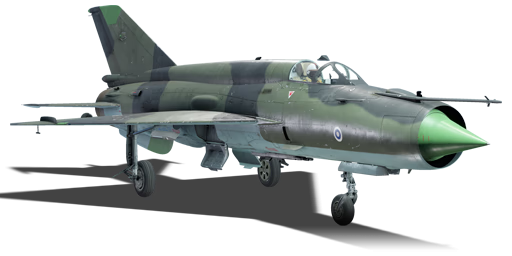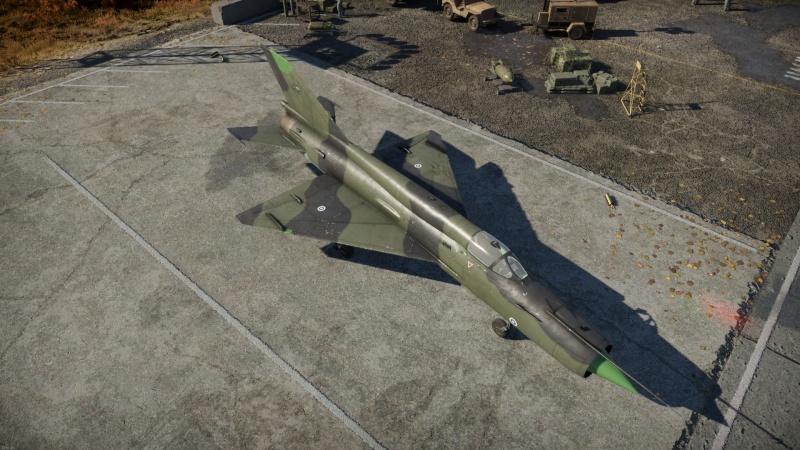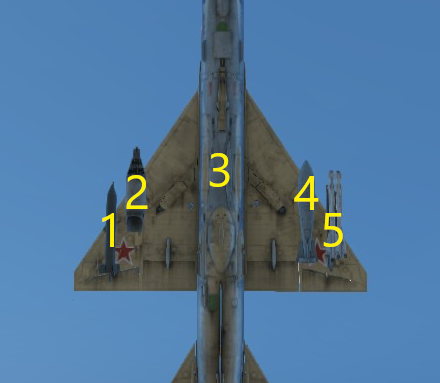MiG-21bis (Sweden)
| This page is about the jet fighter MiG-21bis (Sweden). For other versions, see MiG-21 (Family). |
Contents
Description
In 1963, after rejecting a deal of MiG-19s in search for a new frontline fighter, Finland became the first country outside the Warsaw Pact to purchase the MiG-21, starting with MiG-21F-13s and building their long and prosperous relationship in purchasing Soviet aircraft. Their long service of the Fishbed would culminate in 1977, when Finland acquired 26 examples of the MiG-21bis airframe, specifically the Fishbed-N variant with the Polyot-OI guidance system instead of the Lazur system. These aircraft would remain in Finnish service until 1998, when they were replaced by the F/A-18C Hornet after the end of the Cold War.
The ▄MiG-21bis (NATO Code: Fishbed-N) was introduced in Update "Fire and Ice". This aircraft is completely identical to the MiG-21bis found in the Soviet tech tree, and as such, plays exactly the same. The only differences are cosmetic, such as the camouflage and the names used on its missiles (i.e it has the export R-60MK instead of the R-60M, which is the exact same missile with a different name). The same tips and cautions should be exercised when flying this aircraft; chief of which being the incredible AoA/instantaneous turn and engine acceleration power to utilize, while being cautious of the weak energy retention and subpar missiles compared to many of your adversaries at this battle rating.
General info
Flight performance
The MiG-21bis has absolutely phenomenal acceleration and high-speed performance making it one of the highest-performing aircraft in the game. Firstly, the aircraft is quite fast, being able to reach 1,365 km/h IAS on the deck (at low altitudes) before its wings rip - this means that it is usually capable of outrunning most enemies at its rank, such as Phantoms and the Mirage, with the exception of the F-104 Starfighters which can outrun the MiG-21bis by a small margin. Secondly, the aircraft has the fastest overall acceleration of any aircraft in the game, meaning that it can reach its top speed quickly. However, like all other MiG-21s, the MiG-21bis cannot turn well and tends to bleed speed at an alarming rate during turns. Extended dogfights should therefore be avoided, as the MiG-21bis will often end up on the losing side.
The MiG-21bis has a strong set of control surfaces including an all-moving tail, which keeps the aircraft responsive up to high speeds (>1,300 km/h). However, be aware that the aircraft has two limiting structural factors: the wings' rip speed and structural G limit. Wings will rip at 1,365 km/h IAS, a speed the plane can reach relatively quickly given its phenomenal acceleration. The structural limit of 13G means stronger turns should thus be avoided as there is a risk that they will rip the aircraft's wings.
| Characteristics | Max Speed (km/h at 13,000 m) |
Max altitude (metres) |
Turn time (seconds) |
Rate of climb (metres/second) |
Take-off run (metres) | |||
|---|---|---|---|---|---|---|---|---|
| AB | RB | AB | RB | AB | RB | |||
| Stock | 2,177 | 2,142 | 16000 | 37.8 | 38.8 | 191.0 | 179.8 | 750 |
| Upgraded | 2,305 | 2,240 | 36.4 | 37.0 | 262.7 | 225.0 | ||
Details
| Features | |||||
|---|---|---|---|---|---|
| Combat flaps | Take-off flaps | Landing flaps | Air brakes | Arrestor gear | Drogue chute |
| X | ✓ | ✓ | ✓ | X | ✓ |
| Limits | ||||||
|---|---|---|---|---|---|---|
| Wings (km/h) | Gear (km/h) | Flaps (km/h) | Max Static G | |||
| Combat | Take-off | Landing | + | - | ||
| 1365 | 700 | N/A | 500 | 450 | ~12 | ~6 |
| Optimal velocities (km/h) | |||
|---|---|---|---|
| Ailerons | Rudder | Elevators | Radiator |
| < 650 | < 600 | < 950 | N/A |
Engine performance
| Engine | Aircraft mass | ||||||
|---|---|---|---|---|---|---|---|
| Engine name | Number | Basic mass | Wing loading (full fuel) | ||||
| Tumansky R-25-300 | 1 | 6,132 kg | 371 kg/m2 | ||||
| Engine characteristics | Mass with fuel (no weapons load) | Max Takeoff Weight | |||||
| Weight (each) | Type | 10m fuel | 20m fuel | 30m fuel | 34m fuel | ||
| 1,140 kg | Afterburning axial-flow turbojet | 6,852 kg | 7,532 kg | 8,232 kg | 8,532 kg | 10,000 kg | |
| Maximum engine thrust @ 0 m (RB/SB) | Thrust to weight ratio @ 0 m (WEP) | ||||||
| Condition | 100% | WEP | 10m fuel | 20m fuel | 30m fuel | 34m fuel | MTOW |
| Stationary | 4,040 kgf | 7,344 kgf | 1.07 | 0.98 | 0.89 | 0.86 | 0.73 |
| Optimal | 4,040 kgf (0 km/h) |
9,068 kgf (1,200 km/h) |
1.32 | 1.20 | 1.10 | 1.06 | 0.91 |
Survivability and armour
- 60 mm bulletproof glass - armoured windscreen
- 10 mm steel - bulkhead behind pilot
- Engine and fuel tanks take up most of the fuselage area behind the cockpit
Modifications and economy
Armaments
| Ballistic Computer | |||
|---|---|---|---|
| CCIP (Guns) | CCIP (Rockets) | CCIP (Bombs) | CCRP (Bombs) |
| |
|
|
|
Offensive armament
The MiG-21bis (Sweden) is armed with:
- 1 x 23 mm GSh-23L cannon, belly-mounted (250 rpg)
- 64 x countermeasures
Suspended armament
The MiG-21bis (Sweden) can be outfitted with the following ordnance:
| 1 | 2 | 3 | 4 | 5 | ||
|---|---|---|---|---|---|---|
| S-5K rockets | 16 | 16, 32 | 16, 32 | 16 | ||
| R-3R missiles | 1 | 1 | 1 | 1 | ||
| R-3S missiles | 1 | 1 | 1 | 1 | ||
| R-13M1 missiles | 1 | 1 | 1 | 1 | ||
| R-60MK missiles | 1, 2 | 1 | 1 | 1, 2 | ||
| 820 l drop tanks | 1 |
| Default weapon presets | |
|---|---|
| |
Usage in battles
The MiG-21bis is fairly manoeuvrable at high speeds and since it accelerates quickly and climbs extremely well, it works well as an interceptor (take off, reach around 1,000 km/h, burst climb at a 20-25 degree angle up to 6,000 or 7,000 m and fire on anything that can be sighted) but this method has some risks.
First, the MiG-21bis is prone being hit by a SARH (Semi-Active Radar-Homing) missile such as the AIM-7F or R-24R that can easily shoot the MiG-21bis down since the plane becomes a brick at higher altitudes. And sometimes, even if the MiG-21bis succeeds in its interception objective, some enemies will fly in a different path, so they'll easily sneak up behind the MiG-21bis and take it down with missiles if it is high and slow enough.
The second way to play this plane is to fly at lower altitudes (below 2,000 m) and engage any targets that are encountered, the risk here is that the MiG-21bis is left vulnerable to high-flying enemies that, again, can easily sneak up and take the MiG-21bis down, so pay attention to the surroundings and avoid getting an IR missile shot up into the engine.
The third, and probably safest, way to play the MiG-21bis is to flank around the main fighting area. Side-climb up to around 4-5 kilometres in the air, making sure to avoid the frequented flight paths so the MiG-21bis does not appear on their radar (additionally, turn off the MiG-21bis' radar during this climb so that the enemies' radar-warning receiver does not pick up the MiG-21's radar as well). Idle around the sides until the main body of the enemy team is spotted and then begin turning towards the battlefield to begin engaging targets. As the MiG-21bis returns, keep an eye for any enemy planes that have a similar idea of flanking around. This scenario usually compose of only one enemy fighter climbing up, which a skilled MiG-21bis pilot can begin engaging in their favour if they have a height advantage. However, if two fighters appears, it is best to break off and move towards the vicinity of allies to help engage.
A more risky but rewarding playstyle is to use 2 x R-13M-1 and 4 x R-60MK, or 4 x R-13M-1, and take advantage of MiG-21's 225 m/s climb rate, which in theory, is superior to even the Phantom FG.1 and FGR.2. Radars on most jets can scan ~15 degrees above the horizontal, and by climbing at Mach 0.90-0.95, it is possible to "fly above the radar" and remain undetected at BVR ranges. At high altitudes, the R-13 can be launched at 3 km in a chase and even farther in a dive against lower targets. Although the MiG-21 has a substantial advantage in transonic manoeuvrability, the MiG-21's delta wings cause significant energy bleed in turns as mentioned above. Making high-speed diving attacks is certainly a valid tactic, and fighting from high altitude downwards makes situational awareness easier as most enemies will be at lower altitudes rather than in all directions. This playstyle is most suitable for principled Phantom pilots who are accustomed to maintaining a high energy state.
Enemies worth noting:
- F-4 Phantoms, particularly those with PD radars: these should be the MiG-21bis' priority targets, F-4s are well-known for being extremely versatile and dangerous. These planes accelerate quickly and wield dangerous AIM-7 SARH missiles that can shut down the MiG-21's climbing efforts. While the F-4E variant can be relatively easily countered with chaff to interfere the radar, the ones with PD radars like the F-4J and F-4S can easily track and destroy the MiG-21, requiring notching to break off the radar lock. These planes also have a large number of countermeasures, so the MiG-21's effort to attack them with IR missiles can be easily thwarted. At closer ranges, the fight is more even, as the F-4's Sidewinder missiles can be diverted with countermeasures (though beware if it is a F-4 equipped with the all-aspect AIM-9L Sidewinder missile) However, the dogfight can still be tough if the F-4 has the right pilot playing to its strengths, so be wary and don't assume the MiG-21 has control of the dogfight until the MiG-21's nose is pointed right at the target's six o' clock.
- F-14A Early: The F-14 can be a very dangerous opponent as it has access to the AIM-54 Phoenix and the AIM-7F Sparrow missiles. Multiple F-14s will be able to effectively shut down higher altitudes at the start of the game by launching AIM-54 missiles. Thankfully, the MiG-21 Bis is fitted with a RWR to alert you of any potential incoming treats. Whenever you notice a possible incoming SARH missile at high altitude, the best thing to do is to immediately start to notch the enemy radar (Going 90 degrees in relation to the enemy radar) and release chaff. In a dogfight, the F-14 will gain the upper hand in just a few turns due to the poor energy retention of the MIG-21. However the MiG-21 will have the better turn radius in the first 1-2 turns if the fight starts at high speed.
- The F-16A and MiG-29: Hopefully, the MiG-21bis does not encounter either of these due to the BR differences, but in the case that it does, both of these planes feature advanced radar and highly dangerous SARH missiles. (AIM-7F and R-27ER respectively) However these can still be countered by notching the enemy radar. Both of these planes will have the advantage in a dogfight, the MiG-29 will be able to out-turn you at most speeds while the F-16 is much more agile at lower speed and can easily put you into an energy trap.
Pros and cons
Pros:
- Impressive climb rate of 225 m/s
- Increased flight performance compared to earlier MiG-21s
- Excels against both aerial and ground targets
- Has access to flares that are fired downwards, which means that missiles can be more easily evaded
- Stunning acceleration
- Can wield six R-60MKs
- Huge thrust to weight ratio
Cons:
- As all MiG-21s, it tends to bleed speed in turns, though not as much, thanks to the improved engine
- Pretty bad low speed manoeuvrability
- Doesn't respond well to wing damage - if a wingtip is lost, landing this plane will be very difficult, and if a wing is lost, the plane should be considered as lost
- Poor energy retention
History
By the late 1960s, the Soviet high command sought to increase the effectiveness of the MiG-21 jet fighter, especially at lower altitudes, while at the same time knowing that this could only be achieved by developing a more powerful engine for it. As a result, in 1971, the order to develop what would essentially become the MiG-21bis was issued by the Soviet high command.
As both the power plant manufacturer - Tumansky - as well as the MiG aircraft design bureau were already working on improvements, this order only officially recognized their work, and as a result, by 1972 the MiG-21bis was ready.
Unlike preceding variants, the MiG-21bis managed to strike a balance between performance and endurance. Additionally, the aircraft was fitted with an improved radar and a systems monitor, which made maintenance substantially easier. Furthermore, the maximum number of missiles the aircraft could carry was increased to six while it also received the option to carry the new R-13M air-to-air missile with increased range, higher G-loading and better seeker tracking over the preceding R-3S. Very manoeuvrable R-60 missiles can be carried as well.
The first MiG-21bis was constructed in 1972 and was adopted into service in the same year. Well over 2,200 units of the MiG-21bis would be manufactured, including licence-built versions. The MiG-21bis was one of the most widely produced variants of the aircraft and saw widespread use with numerous operators around the globe. In fact, some modernized modifications are still in combat use today.
Media
- Skins
See also
Links to the articles on the War Thunder Wiki that you think will be useful for the reader, for example:
- reference to the series of the aircraft;
- links to approximate analogues of other nations and research trees.
External links
Paste links to sources and external resources, such as:
- topic on the official game forum;
- other literature.
| Mikoyan-Gurevich Design Bureau (Микоя́н и Гуре́вич Опытное конструкторское бюро) | |
|---|---|
| Fighters | MiG-3-15 · MiG-3-15 (BK) · MiG-3-34 |
| I-225 | |
| Jet fighters | MiG-9 · MiG-9 (l) |
| MiG-15 · MiG-15bis · MiG-15bis ISh | |
| MiG-17 | |
| MiG-19PT | |
| MiG-21F-13 · MiG-21PFM · MiG-21S (R-13-300) · MiG-21SMT · MiG-21bis | |
| MiG-23M · MiG-23ML · MiG-23MLD | |
| MiG-27M · MiG-27K | |
| MiG-29 · MiG-29SMT | |
| Export/Licensed | ␗MiG-9 · ␗MiG-9 (l) |
| ◊MiG-15bis · ◔MiG-15bis · J-2* | |
| MiG-17AS · ◔MiG-17PF · J-4* · Shenyang F-5* | |
| ◊MiG-19S · J-6A* | |
| ◄MiG-21 SPS-K · ◊MiG-21MF · ◔MiG-21MF · ▄MiG-21bis · ◔MiG-21bis-SAU · ◊MiG-21bis-SAU · ◊MiG-21 "Lazur-M" · ▄MiG-21 Bison · J-7II** | |
| ◊MiG-23BN · ◊MiG-23MF · ◔MiG-23MF · ◊MiG-23MLA | |
| ◔MiG-29 · ◊MiG-29 · ◄MiG-29G | |
| *Licensed and domesticated with Chinese designations. | |
| **Unlicensed, reverse-engineered and domesticated with Chinese designations. | |
| See Also | Shenyang · Chengdu |
| Sweden jet aircraft | |
|---|---|
| Fighters | J21RA |
| J29A · A29B · J29D · J29F | |
| J32B | |
| J34 | |
| J35A · J35D | |
| JA37C · JA37D · JA37DI · JA37DI F21 | |
| JAS39A · JAS39C | |
| Strike aircraft | A21RB |
| A32A · A32A Röd Adam | |
| A28B | |
| AJ37 · AJS37 | |
| SK60B · SAAB-105G | |
| Export | SAAB-105OE |
| Finland | ▄Vampire FB 52A · ▄MiG-21bis · Saab J35XS |






